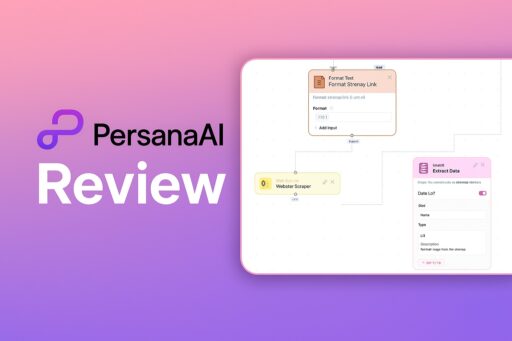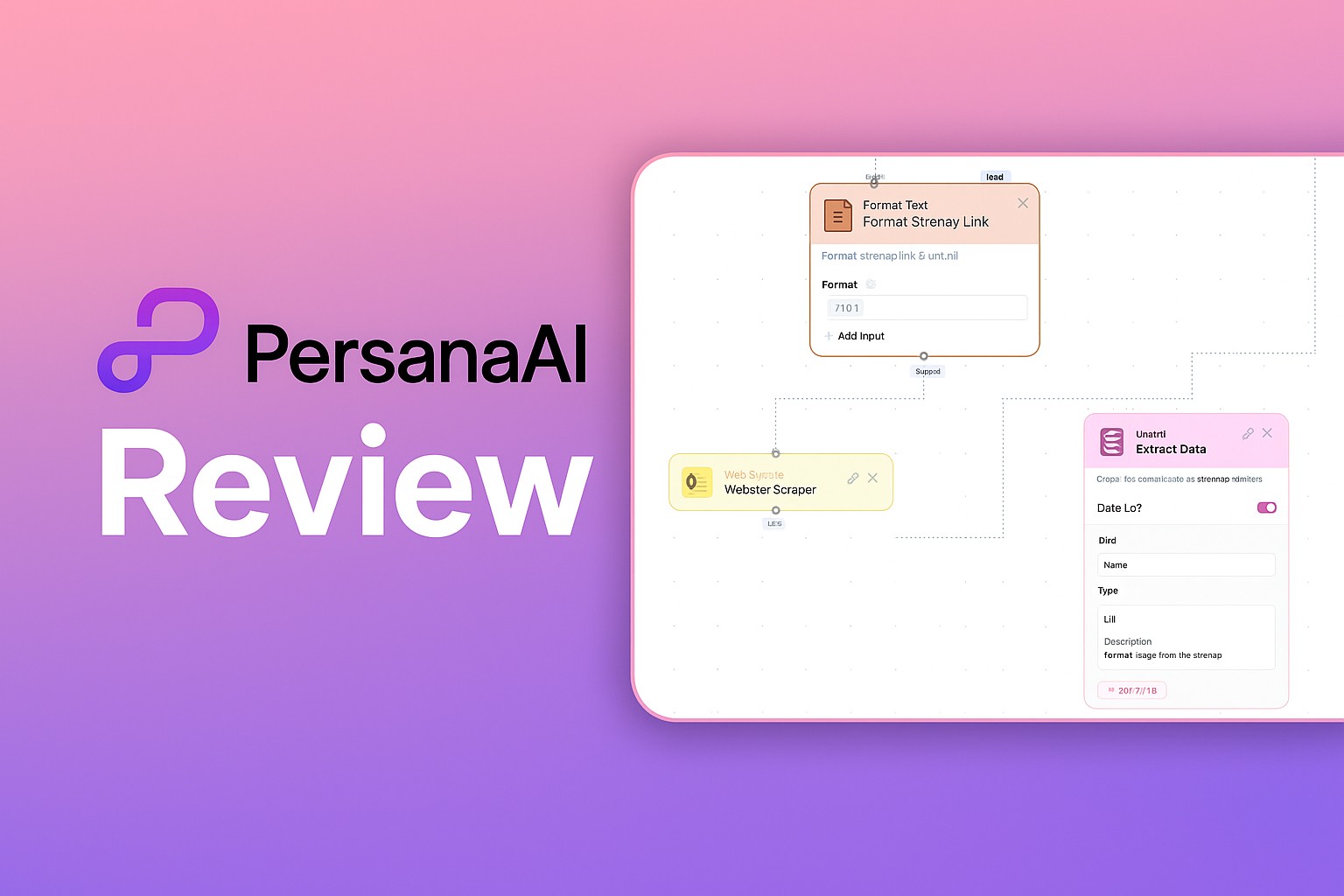Last Updated: November 16, 2025
Every time I scroll LinkedIn these days, I see another AI tool promising to “revolutionize” sales.
Most of them? *Yawns* Pretty forgettable.
But Persana AI caught my attention because teams aren’t using it like another prospecting tool – they’re using it as their entire GTM engine.
I’ve been testing Persana AI for the past month and a half, building workflows, enriching leads for Bloomberry and Revealera, and seeing how it handles real-time data. And I decided to write a review b/c I know this might be helpful for anyone considering Persana.
I’ll cover what the tool promises to do, what I honestly think of it (the pros and cons I’ve come across), and who I think it’s best suited for (and who should probably look elsewhere).
Let’s get into it.
(If you want my TLDR, scroll to the bottom or click here.)
Who is Persana AI for?
When you land on the Persana AI website, you’re immediately hit with their positioning:
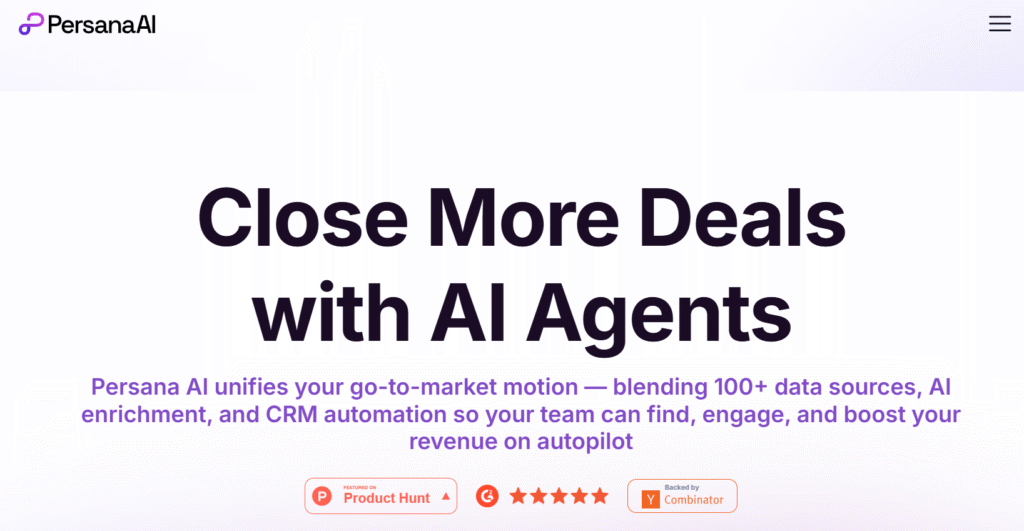
“Close More Deals with AI Agents”
And right below it: “Persana AI unifies your go-to-market motion – blending 100+ data sources, AI enrichment, and CRM automation so your team can find, engage, and boost your revenue on autopilot.”
Right away, you can tell this isn’t just another contact database. Persana is built for teams who think about go-to-market as a system, not a series of disconnected tasks.
At its core, Persana helps you turn signals into pipeline by combining prospecting, enrichment, AI research, and workflow automation into one platform. It’s for people who are tired of juggling five different tools to accomplish what should be one seamless motion.
So who gets the most value? Based on my testing:
- Growth and sales teams: If you’re running outbound at scale and need real-time enrichment, live scoring, and signal-based triggers, Persana becomes your single source of truth.
- Revenue operations teams: RevOps folks will appreciate how Persana bridges the gap between marketing automation and sales execution. You can orchestrate entire account journeys based on lots of signals.
- Startup founders and sales leaders: If you’re building a GTM motion from scratch or scaling fast, Persana gives you enterprise-grade capabilities without needing a massive tech stack.
- Account executives and SDRs: Reps get hyper-personalized context on every account – pain points extracted from recent news, job postings analyzed for hiring priorities, decision-makers automatically identified and validated.
- Marketing teams running ABM: Persana’s autonomous orchestration monitors your target accounts 24/7 and triggers campaigns the moment relevant signals fire.
If you’re currently using Clay, Apollo, or Clearbit and feeling like you’re stitching together too many tools, Persana might be exactly what you need. Think of it as if your CRM, enrichment provider, and marketing automation platform had a baby that actually understood GTM strategy.
Persana AI’s popular features
Persana is a seriously powerful platform. Like most powerful tools, there’s a learning curve – but it’s surprisingly manageable compared to piecing together five different systems.
During my testing, I learned the platform works across three core pillars:
- Prospecting: Live search, filtering, enrichment, and validation – all in real time, not from stale CSVs
- Signals: Intent monitoring across funding, hiring, leadership changes, tech adoption, and more
- AI Research: Autonomous agents that analyze company news, job posts, social activity, and extract actionable insights
What blew my mind was how these three systems work together, not in silos.
For example, I set up a workflow that monitors companies in my ICP for Series B funding announcements. The moment a signal fires, Persana automatically:
- Enriches the account with decision-makers in revenue roles
- Validates their contact info
- Runs an AI research agent to analyze their recent hiring patterns and extract pain points
- Feeds personalized talking points into my outreach sequence
That entire flow runs automatically. No exports, no copy-pasting between tools, no waiting for data to refresh overnight.
Live prospecting that actually stays fresh
Here’s what makes Persana different from traditional prospecting tools:
You’re not downloading CSVs that go stale in 48 hours. You’re searching and filtering against live data that updates continuously. When someone changes jobs, gets promoted, or their company raises funding, Persana knows – often before it hits their LinkedIn.
The platform lets you:
- Search across funding events, role changes, team growth, and company signals in real time
- Auto-enrich and validate contacts the second they’re surfaced
- Score leads based on live signals, not just firmographic fit
- Surface lookalike accounts before your competitors even open LinkedIn
- Feed high-fit prospects directly into sequences without any manual steps
I built a saved search that runs continuously and auto-enriches new matches. My prospect list is always fresh, always scored, always ready to work.
Signal-based orchestration
This is where Persana gets really interesting.
Most teams are still running outbound off static lists. By the time you finish your campaign, half your data is outdated and the timing is all wrong.
Persana flips that model. Instead of “campaign → accounts,” it’s “signals → action.”
You can monitor accounts for:
- Funding rounds (Series A through growth equity)
- Hiring bursts (department-specific growth signals)
- Leadership changes (new CROs, VPs of Sales, etc.)
- Tech stack changes (implemented or removed tools)
- Social posts and company announcements

When any signal fires, you can trigger automated workflows: enrichment, research, personalized outreach, CRM updates, Slack notifications – whatever your playbook requires.
I set up a simple monitor for companies posting job listings for “Head of Revenue Operations.” Within two weeks, Persana flagged 8 companies, auto-enriched the hiring managers, and I had meaningful conversations with 5 of them. That’s pipeline from timing, not just fit.
AI Research that actually saves time
Here’s the part that honestly surprised me the most.
Persana’s AI Research agents (dubbed “Persana Quantum Agent”) don’t just scrape websites – they understand context and extract insights your reps can actually use.
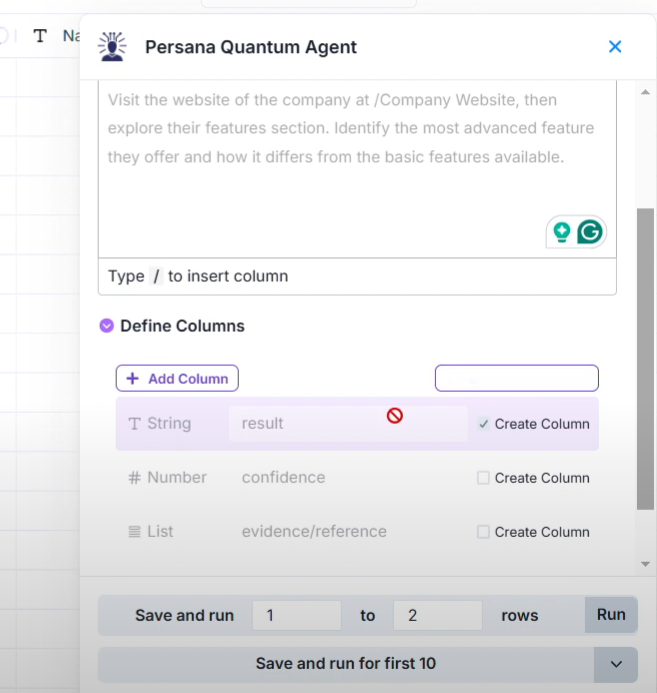
You can point an AI agent at a company and ask it to:
- Analyze recent news articles and extract strategic priorities
- Review job postings to identify pain points and growth areas
- Monitor social media for leadership commentary and company updates
- Summarize all findings into actionable talking points
What used to take 15-20 minutes of manual research now happens automatically. The AI doesn’t give you generic summaries – it pulls targeted intelligence from the actual language your ICP uses when they talk about their challenges.
Integration with your existing stack
Persana doesn’t want to replace your CRM – it wants to make it smarter.
The platform integrates with:
- Salesforce and HubSpot for bidirectional sync
- Outreach, SalesLoft, Apollo for sequence orchestration
- Slack for real-time signal notifications
- LinkedIn Sales Navigator for enhanced prospecting
- Plus webhook support for custom integrations
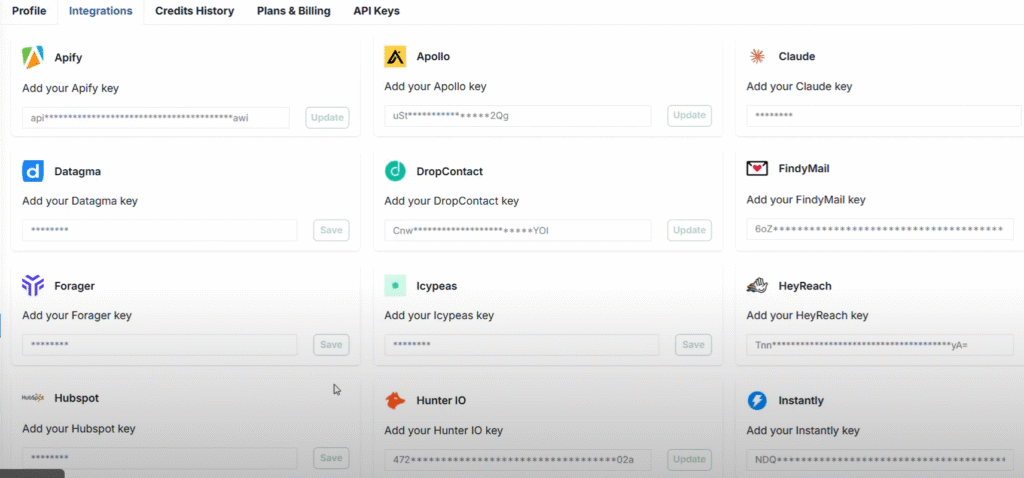
What impressed me is that these integrations aren’t one-way data dumps. Persana continuously enriches your CRM records, updates contact data, and feeds insights back into your existing tools. It’s a living system, not a static enrichment vendor.
How much does Persana AI cost?
Pricing is always the elephant in the room with AI-powered GTM tools. Running live data, AI research, and continuous enrichment isn’t cheap—but it’s also way more valuable than buying a stale contact database.
Persana uses a credit-based pricing model where 1 email = 1 credit and 1 phone number = 10 credits. They offer both monthly and annual billing, with a 20% discount if you pay annually.
Persana AI’s pricing tiers

Here’s the breakdown of their plans (annual pricing):
Free: $0/month with 50 credits to test the platform. Includes unlimited users, 100+ data providers, AI research agents, and basic enrichment. Good for getting a feel for how it works.
Starter: $68/month (billed annually) with 24,000 credits/year. Best for individuals just getting started. Includes credit rollover, web scrapers, and up to 7,000 people/company search.
Growth (Most Popular): $151/month (billed annually) with 60,000 credits/year. Adds email sequencing integrations (Smartlead, Instantly, Salesloft, Outreach), lookalike finder, webhooks, and up to 20,000 people/company search.
Pro: $400/month (billed annually) with 216,000 credits/year. For growth teams that need ABM capabilities, CRM integration (HubSpot, Salesforce), signals & intent triggers, company funding data, and up to 30,000 people/company search.
Unlimited: $600/month (billed annually) with 600,000 credits/year. Most cost-effective for high-volume teams. Includes autopilot AI agents, email sequencing and sending, unlimited searches (fair use), unlimited enrichments, and white-glove Slack support.
Enterprise: Custom pricing. Everything in Unlimited plus full AI SDR agents, custom playbooks, dedicated account team, and unlimited exports.
The real question isn’t “what does Persana cost?” It’s “what does it cost NOT to have real-time data and signal-based orchestration?” If you’re losing deals because competitors reached out first, or burning rep time on manual research, the ROI case writes itself.
The credit system is pretty straightforward: if you’re enriching mostly emails, your credits go further. If you need a lot of phone numbers, you’ll burn through credits faster since phones cost 10x more.
Most teams I’ve talked to land on either Growth (for smaller teams) or Pro (once you need CRM integration and ABM). The Unlimited plan makes sense if you’re running high-volume outbound and want predictable costs.
Persana AI scalability (and security)
When you’re feeding your entire prospect database, CRM data, and automation workflows through a platform, you need to know it’s secure and can handle volume.
Persana takes security seriously. The platform is:
- SOC 2 Type II compliant (audited for security controls)
- GDPR compliant (critical if you’re prospecting internationally)
- Encrypted at rest and in transit (industry-standard protection)
- Role-based access controls (so you can limit who sees what data)
They also don’t use your data to train AI models, which is table stakes for B2B tools but worth confirming.
On the scalability front, Persana is already being used by enterprise teams running thousands of enrichments per day. I tested it with bulk operations and didn’t see any meaningful slowdowns.
Overall? Persana is enterprise-ready. If security, compliance, and uptime are concerns, you can trust the platform with your GTM data.
Persana AI pros and cons
After using Persana for over a month and building multiple workflows, here’s my honest take on the strengths and weaknesses.
Persana AI pros
Here’s what genuinely impressed me:
- Live data that actually stays current: Unlike traditional prospecting tools where data goes stale overnight, Persana’s live search and continuous enrichment mean you’re always working with fresh information.
- Signal-based orchestration is a game-changer: Being able to trigger workflows based on funding, hiring, tech adoption, and other intent signals transforms how you run ABM. You’re responding to real buyer signals, not guessing.
- AI Research saves massive amounts of time: Automatically analyzing company news, job posts, and social activity – then extracting actionable talking points – is incredible. What used to take 15-20 minutes now happens automatically.
- All-in-one platform reduces tool sprawl: If you’re tired of juggling Clay + Apollo + Clearbit + 6sense + your CRM, Persana consolidates most of that into one system.
- Hyper-personalization at scale: The combination of enrichment + signals + AI research gives reps actual context, not just templated fields.
- Integration quality: The bidirectional sync with CRMs and outreach tools means Persana becomes part of your existing workflow, not a separate silo.
Overall, Persana delivers on its promise of being a GTM engine, not just a prospecting tool.
Persana AI cons
Nothing’s perfect. Here are the rough edges I encountered:
- Learning curve: The platform has a lot of depth, which means it takes time to fully understand. If you’re coming from simpler tools, expect to invest in proper onboarding.
- Pricing can add up with volume: Usage-based pricing means heavy enrichment and research can drive costs up. You need to be thoughtful about credit management.
- Some features still maturing: Persana is adding capabilities quickly, but there are still some workflow gaps compared to more established platforms.
- Occasional performance hiccups: I experienced some slow loading times during heavy usage. These feel like growing pains rather than fundamental problems.
- UI polish: The interface is functional but not as polished as something like HubSpot. There are minor UX friction points here and there.
The cons are mostly about maturity and polish – not fundamental problems with the platform’s value proposition. If you’re willing to invest time in learning the system, the ROI is absolutely there.
TLDR: My final thoughts
If you made it this far, you probably have a solid understanding of what Persana AI does and who it’s for. But if you’re just skimming, here’s the summary.
Is Persana AI worth it?
✅ Yes, if you’re building a modern, signal-driven GTM motion and need real-time data, AI research, and workflow orchestration in one platform. This is especially true for B2B teams selling to mid-market and enterprise accounts where timing and personalization matter.
❌ Maybe not, if you’re running simple outbound with basic enrichment needs, or if you’re not ready to invest time in learning a more sophisticated platform. Simpler tools like Apollo might be a better fit.
What makes Persana AI unique?
Persana doesn’t just give you contact data – it gives you a living GTM system that thinks, learns, and responds to buyer signals in real time.
The combination of live prospecting + signal-based orchestration + AI research is something I haven’t seen executed this well in any other platform. Instead of manually stitching together five different tools, you get one system that handles discovery, enrichment, personalization, and orchestration.
It’s not just about having more contacts. It’s about having the right contacts at the right time with the right context.
Who should try Persana AI?
You should seriously consider Persana if:
- You’re running ABM and need to respond to intent signals, not just static lists
- You’re tired of juggling multiple enrichment, research, and automation tools
- Your reps spend too much time on manual research and not enough on selling
- You’re losing deals because competitors reach out at better times
- You need hyper-personalization at scale, not generic templated outreach
Final recommendation
Give Persana a serious look if you’re building a modern GTM motion. The platform delivers on its promise of being a system, not just another data vendor.
I’ve tested a lot of GTM tools, and Persana is one of the few that actually transforms how teams operate rather than just adding another dashboard to check.
If you got any comments on things to add to this review, or second opinions on Persana, feel free to email me at henley@revealera.com.
Disclosure: This review is based on my own testing and research. I’m not affiliated with Persana AI and wrote this to help teams understand what the platform actually does beyond the marketing copy.
